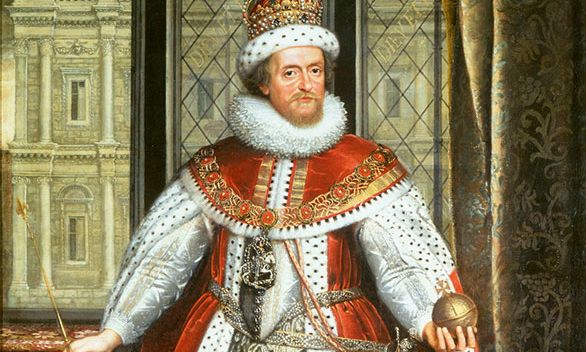Paul van Somer’s portrait of James VI and I (around 1620) Royal Collection Trust, © Her Majesty Queen Elizabeth II
On 7 May 1603, James VI of Scotland and now James I of England rode into the capital of his new kingdom: the Stuarts had arrived. Thousands of Londoners gathered to watch and, at Stamford Hill, the Lord Mayor was waiting to present the keys of the city while 500 magnificently dressed citizens joined the procession on horseback.
There was a small technical hitch. James should have been bound for the Tower of London until proclaimed and crowned but, despite frantic building work, it was nowhere near ready. As Simon Thurley recounts—twitching aside a velvet curtain to reveal the shabby backstage machinery—parts of the Tower, traditional powerbase of English monarchs since William the Conqueror, were derelict. The great hall gaped open to the skies and for decades the royal lodgings had been junk rooms. During James’s stay, a screen wall had been built to hide a gigantic dung heap.
Art and architecture for the Stuart monarchs in England—an extraordinary period when the world was turned upside down twice with the execution of one king (Charles I in 1649) and the deposition of another (James II in 1688)—were neither about keeping out the weather nor entirely about outrageous luxury. The royal residences were complex statements of power, authority and rank. The architecture controlled the jealously guarded access to the king and queen: in many reigns, almost anyone could get in to stand behind a railing and watch the king eating or praying, and a surprisingly wide circle was admitted to the state bedrooms, but only a handful got into the actual sleeping places. The choices of fine and decorative art from England, Italy, France or the Low Countries, who got to see it—whether an English Mortlake or a Flemish tapestry, a bed made of sturdy Tudor Oak or an opulent French one, swathed in fabulous imported gold-swagged silk—and where courtiers or mistresses were stashed, were all significant decisions and interpreted as such.
From James’s astonishing takeover of Royston in Hertfordshire as a hunting base—nobody who reads Thurley’s account will again see it as just (forgive me) a rather dull stop on the road north—to the disastrous obstetric history of Queen Anne, which ended the Stuart reign in 1714, the sums spent were extraordinary, even without translating into contemporary terms or comparison with the golden wallpaper of current Prime Minister Boris Johnsons’ flat. Anne of Denmark, wife of James I, spent £45,000 transforming Somerset House on the Strand. Henrietta Maria, wife of Charles I, spent another fortune, including on the most sensitive architecture of the Stuart reigns, an elaborate Roman Catholic chapel (ransacked by a rioting mob in the mid-century Civil Wars).
Thurley recreates some vanished houses, including the reputedly beautiful Theobalds in Hertfordshire and a very private pleasure dome within a glorious garden in Wimbledon. Perhaps the most extraordinary insight is that in his last months, imprisoned on the Isle of Wight and engaged in failing negotiations with the Parliamentarians, Charles I was also considering plans to completely rebuild Whitehall palace, a project ended by the axe at the Banqueting House, one of the few buildings that would have been kept.
There’s less architectural history and more gossip in this lively compendium than in the detailed studies of individual buildings Thurley has already published, but there are myriad floor plans and contemporary engravings, and plenty to set the mind of the general reader wandering through the long galleries—the new Whitehall would have had a 1,000 ft gallery—and a 29-page bibliography for those who want more.
• Simon Thurley, Palaces of Revolution: Life, Death and Art at the Stuart Court, William Collins, 560pp, eight colour plates plus black-and-white intext illustrations, £25 (hb), published September 2021
• Maev Kennedy is a freelance arts and archaeology journalist and a regular contributor to The Art Newspaper

